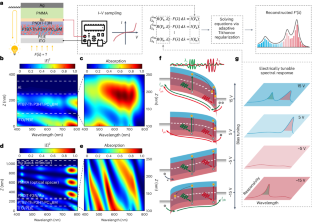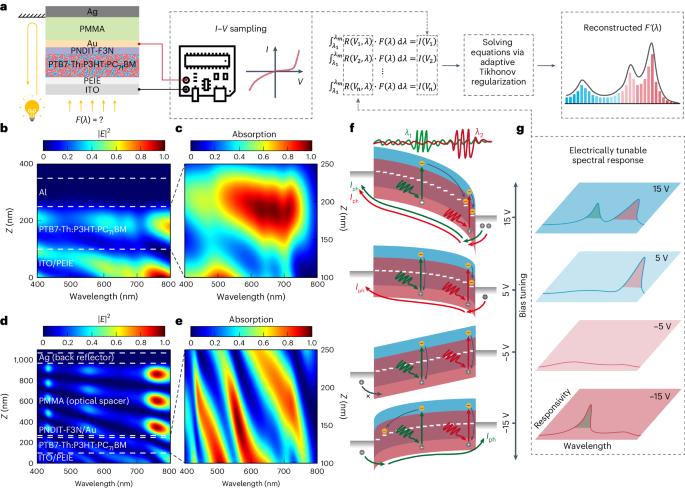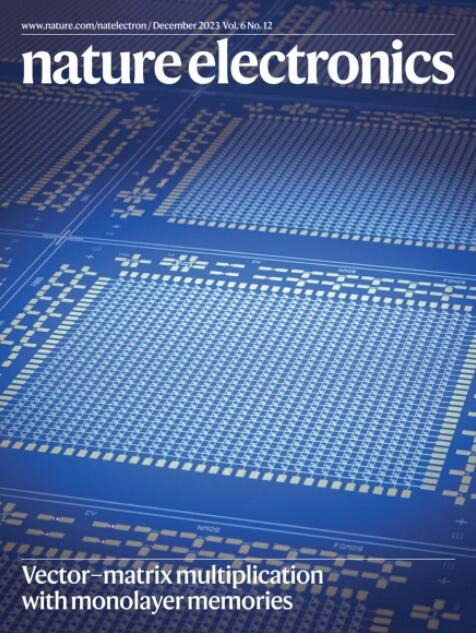一种基于有机光电探测器的微型光学光谱仪,具有电可调光谱响应
IF 40.9
1区 工程技术
Q1 ENGINEERING, ELECTRICAL & ELECTRONIC
引用次数: 0
摘要
微型光学光谱仪可用于便携式和可穿戴式应用。这类设备通常基于提供不同光谱响应的光电探测器阵列,或使用复杂的微型色散光学器件。然而,这些方法通常会产生厘米大小的大型系统。在此,我们报告了一种微型光学光谱仪,它基于一个光学间隔集成的光倍增型有机光电探测器,具有可偏置调节的光谱响应。这种方法可以根据一组不同偏置电压下测得的光电流计算重建入射光光谱。该器件占地面积为 0.0004 平方厘米,能够在整个可见光波长范围内宽带工作,分辨率为 5 纳米以下。为了说明这种方法的能力,我们制作了一个 8 × 8 光谱传感器阵列,可用于高光谱成像。本文章由计算机程序翻译,如有差异,请以英文原文为准。


A microsized optical spectrometer based on an organic photodetector with an electrically tunable spectral response
Miniaturized optical spectrometers could be of use in portable and wearable applications. Such devices have typically been based on arrays of photodetectors that provide distinct spectral responses or use complex miniaturized dispersive optics. However, these approaches often result in large centimetre-sized systems. Here we report a microsized optical spectrometer that is based on an optical-spacer-integrated photomultiplication-type organic photodetector with a bias-tunable spectral response. The approach allows the computational reconstruction of an incident light spectrum from photocurrents measured under a set of different bias voltages. The device, which has a footprint of 0.0004 cm2, is capable of broadband operation across the entire visible wavelength with a sub-5-nm resolution. To illustrate the capabilities of this approach, we fabricate an 8 × 8 spectroscopic sensor array that can be used for hyperspectral imaging. Optical-spacer-integrated photomultiplication organic photodetectors with electrically tunable spectral response can provide high-resolution optical characterization across the visible spectrum.
求助全文
通过发布文献求助,成功后即可免费获取论文全文。
去求助
来源期刊

Nature Electronics
Engineering-Electrical and Electronic Engineering
CiteScore
47.50
自引率
2.30%
发文量
159
期刊介绍:
Nature Electronics is a comprehensive journal that publishes both fundamental and applied research in the field of electronics. It encompasses a wide range of topics, including the study of new phenomena and devices, the design and construction of electronic circuits, and the practical applications of electronics. In addition, the journal explores the commercial and industrial aspects of electronics research.
The primary focus of Nature Electronics is on the development of technology and its potential impact on society. The journal incorporates the contributions of scientists, engineers, and industry professionals, offering a platform for their research findings. Moreover, Nature Electronics provides insightful commentary, thorough reviews, and analysis of the key issues that shape the field, as well as the technologies that are reshaping society.
Like all journals within the prestigious Nature brand, Nature Electronics upholds the highest standards of quality. It maintains a dedicated team of professional editors and follows a fair and rigorous peer-review process. The journal also ensures impeccable copy-editing and production, enabling swift publication. Additionally, Nature Electronics prides itself on its editorial independence, ensuring unbiased and impartial reporting.
In summary, Nature Electronics is a leading journal that publishes cutting-edge research in electronics. With its multidisciplinary approach and commitment to excellence, the journal serves as a valuable resource for scientists, engineers, and industry professionals seeking to stay at the forefront of advancements in the field.
 求助内容:
求助内容: 应助结果提醒方式:
应助结果提醒方式:


